
HW Virginis, abbreviated HW Vir, is an eclipsing binary system, approximately 563 light-years away based on the parallax measured by the Gaia spacecraft, in the constellation of Virgo. The system comprises an eclipsing B-type subdwarf star and red dwarf star. The two stars orbit each other every 0.116795 days.
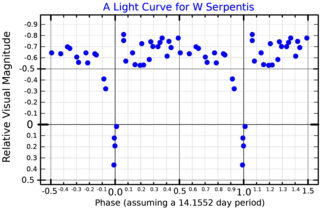
W Serpentis is an eclipsing binary star in the constellation Serpens. It is always too faint to be seen with the naked eye, varying between apparent magnitudes 8.42 and 10.2 with a period of just over 14 days. This is mainly due to eclipses; however, variations in its period indicate there are some innate changes in luminosity of one or both component stars as they interact with each other, and it has been difficult to disentangle the light to determine their nature. The period is increasing by 14 seconds a year, indicating that a massive amount of material is being transferred from the larger fainter star to the smaller brighter one.
16 Serpentis is a binary star system in the Serpens Caput portion of the equatorial constellation of Serpens, located 228 light years from the Sun. It is visible to the naked eye as a fain, orange-hued star with an apparent visual magnitude of 5.261. The system is moving further from the Earth with a heliocentric radial velocity of +3 km/s.

FL Lyrae is the variable star designation for an eclipsing binary star system in the northern constellation of Lyra. The combined apparent magnitude of the pair is 9.36, which means they are too faint to be seen with the naked eye. Parallax measurements put the system at a distance of around 437 light years from the Sun. This star system was in the view field of the Kepler space telescope during 2009−2014, which allowed monitoring during that spacecraft's mission.
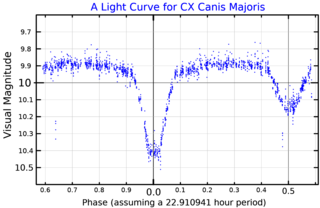
CX CMa is a blue variable star in the Canis Major constellation. Discovery of this variable is usually credited to German Astronomer Cuno Hoffmeister in 1931, although this remains uncertain.
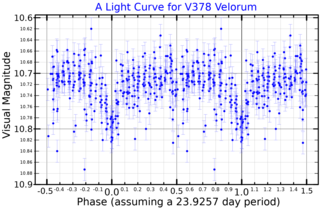
WR 12 is a spectroscopic binary in the constellation Vela. It is an eclipsing binary consisting of a Wolf-Rayet star and a luminous companion of unknown spectral type. The primary is one of the most luminous stars known.
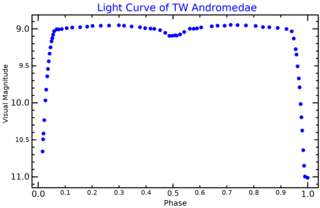
TW Andromedae is an eclipsing binary star, classified also as an Algol variable star, in the constellation Andromeda. Its brightness varies with a period of 4.12 days, and has a typical brightness of magnitude 8.98 but decreasing down to a magnitude of 11.04 during the main eclipse.

HD 139319 is a ternary system composed of the binary Algol variable star known as TW Draconis, and a main-sequence companion star at a separation of 3 arcseconds. The system lies in the constellation of Draco about 540 light years away.

HD 326823, also known as V1104 Scorpii, is a binary star containing a unique emission-line star, which is in the midst of transitioning to a nitrogen-rich Wolf-Rayet star, as well as being a candidate Luminous blue variable, located 4,142 light years away in the constellation of Scorpius. The primary is very evolved, because it is composed of almost entirely helium, and only 3% of it is still hydrogen, and it has lost most of its mass to the now-very-massive secondary. The underlying mechanisms and mass transfers in the system are comparable to other W Serpentis systems, such as Beta Lyrae and RY Scuti.

EQ Tauri is a triple star system in the equatorial constellation of Taurus that includes a contact eclipsing binary. The system is too faint to be viewed with the naked eye, having a baseline apparent visual magnitude of 10.5. During the primary eclipse, the brightness of the system drops to magnitude 11.03, then to 10.97 during the secondary minimum. The secondary eclipse is total. Based on parallax measurements, it is located at a distance of approximately 730 light years from the Sun.
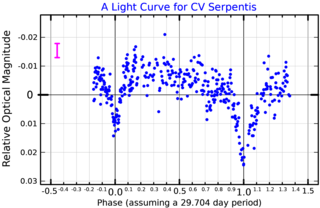
CV Serpentis is a binary star system in the equatorial constellation of Serpens. It is a detached eclipsing binary with an orbital period of 29.7 days. The system includes a Wolf–Rayet (WR) star with the identifier WR 113. The system is located at a distance of approximately 6,700 light years from the Sun based on parallax measurements. It is a member of the Serpens OB2 association of co-moving stars.

AG Virginis is an eclipsing binary star system in the equatorial constellation of Virgo. With a maximum apparent visual magnitude of 8.51 it is too faint to be visible to the naked eye. The system is located at a distance of approximately 820 light years from the Sun based on parallax measurements.

RW Tauri is a binary star system in the equatorial constellation of Taurus. It has the designation HD 25487 in the Henry Draper Catalogue, while RW Tauri is the variable star designation. With a peak apparent visual magnitude of 8.05, it is too faint to be visible to the naked eye. The distance to this system is approximately 940 light years based on parallax measurements.

HU Tauri is a tight binary star system in the equatorial constellation of Taurus. It is an eclipsing binary, which means that the member stars periodically eclipse each other every 2.056 days. They have a combined apparent visual magnitude of 5.85, which is bright enough to be dimly visible to the naked eye. During the primary eclipse, the magnitude drops to 6.68, while the secondary eclipse decreases the magnitude to 5.91. The distance to this system, based on parallax measurements, is approximately 414 light years.

RR Lyncis is a star system in the northern constellation of Lynx, abbreviated RR Lyn. It is an eclipsing binary of the Algol type; one of the closest in the northern sky at an estimated distance of approximately 263 light years based on parallax measurements. The system is faintly visible to the naked eye with a combined apparent visual magnitude of 5.53. During the primary eclipse the brightness drops to 6.03, while it decreases to magnitude 5.90 with the secondary eclipse. The system is drifting closer to the Sun with a radial velocity of −12 km/s.
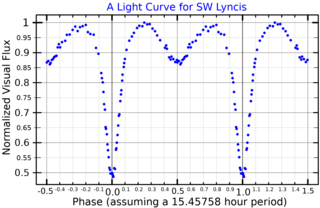
SW Lyncis is a binary or possibly a multiple-star system in the northern constellation of Lynx, abbreviated SW Lyn. With a combined apparent visual magnitude of 9.58, it is too faint to be visible to the naked eye. The system is located at a distance of approximately 970 light years based on parallax measurements, and is drifting further away with a net radial velocity of about +32 km/s.

VV Ursae Majoris is a binary star system in the northern circumpolar constellation of Ursa Major, abbreviated VV UMa. It is a variable star system with a brightness that cycles around an apparent visual magnitude of 10.19, making it too faint to be visible to the naked eye. The system is located at a distance of approximately 1,500 light years based on parallax measurements.

RS Sagittarii is an eclipsing binary star system in the southern constellation of Sagittarius, abbreviated RS Sgr. It is a double-lined spectroscopic binary with an orbital period of 2.416 days, indicating that the components are too close to each other to be individually resolved. The system has a combined apparent visual magnitude of 6.01, which is bright enough to be faintly visible to the naked eye. During the primary eclipse the brightness drops to magnitude 6.97, while the secondary eclipse is of magnitude 6.28. The distance to this system is approximately 1,420 light years based on parallax measurements.
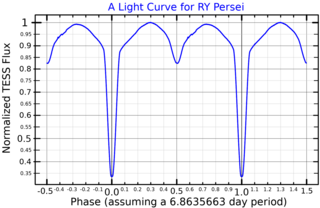
RY Persei is a variable star in the northern constellation of Perseus, abbreviated RY Per. It is an Algol variable with a period of 6.8635663 days, which indicates this is an eclipsing binary star system with an orbital plane oriented close to the line of sight from the Earth. The system has a maximum apparent visual magnitude of 8.50, which drops down to magnitude 10.25 during the eclipse of the primary component, then to 8.65 with the secondary eclipse. Based on parallax measurements, this system is located at a distance of approximately 2,960 light years from the Sun, but is drifting closer with a radial velocity of −12 km/s.

RT Persei is a variable star system in the northern constellation of Perseus, abbreviated RT Per. It is an eclipsing binary system with an orbital period of 0.84940032 d (20.386 h). At peak brightness the system has an apparent visual magnitude of 10.46, which is too faint to be viewed with the naked eye. During the eclipse of the primary this decreases to magnitude 11.74, then to magnitude 10.67 with the secondary eclipse. The distance to this system is approximately 628 light years based on parallax measurements. It is drifting closer with a heliocentric radial velocity of about −12 km/s.



















